BUILDING OF AMERICAN LOCOMOTIVES.—I.
Scientific American—June 7, 1902
It would be difficult to find a form of mechanical construction
in America which bears more strongly the imprint of our national
characteristics than the American locomotive. In its general appearance,
constructive details, and unquestionable convenience of operation,
it stands entirely distinct as a type among the hundred-and-one
styles of locomotives that are manufactured in the shops of the
world. This national individuality is seen even more strongly
in the great industrial establishments in which our locomotives
are made, where labor-saving machinery and carefully-thought-out
methods of shop management have enabled us to build at a speed
and price which cannot be approached by any other nation. The
magnitude of the locomotive industry in this country was emphasized
in the festivities which attended the recent completion of their
20,000th locomotive by one of the locomotive works of this country,
an event which occurred in the spring of the present year. The
early founding of the Baldwin Locomotive Works, its rapid growth,
the many standard types of locomotives which have been originated
in the shops of the company, and the fact that its locomotives
have been for years finding their way to the four corners of the
earth render the works thoroughly representative of the locomotive
industry in this country.
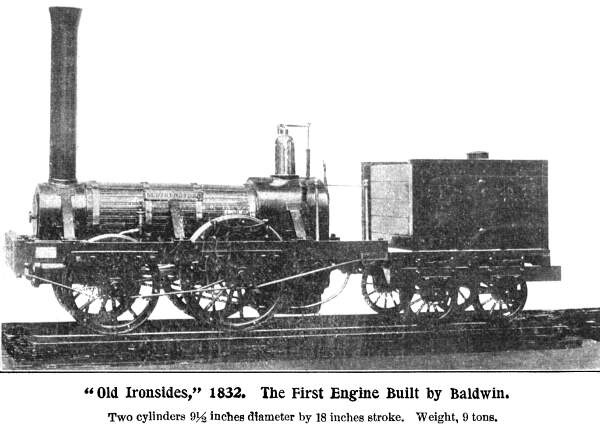 Mathias W. Baldwin, who founded
the establishment, started in business as a jeweler in a small
shop in Philadelphia in the year 1819. In 1830 the steam railroad
was beginning to make its appearance and establishing itself in
this country, and to gratify public interest the proprietor of
a Philadelphia museum gave an order to Baldwin for the construction
of a miniature locomotive for exhibition. In the spring of 1831
the work was completed and the toy was set in motion on a circular
railroad track at the museum. The success of the model brought
an order to Baldwin for a locomotive from the Philadelphia, Germantown
& Norristown Railroad Company. Guided by his experience with
the little model, and by some memoranda which he had taken of
a locomotive recently imported from England by the Camden &
Amboy Railroad Company, Baldwin completed the curious and historical
locomotive known as "Old Ironsides," of which we give
an illustration on our front page. The engine was tried November
23, 1832, and did duty on the Germantown road and, later, on other
roads for a period of over twenty years. The "Ironsides"
was a four-wheeled engine, modeled after the English pattern of
those days, and it weighed in running order something over five
tons. The cylinders were placed beneath the smokebox and connected
to a pair of cranks on the rear axle, which was placed in front
of the firebox. The driving wheels were 54 inches in diameter,
and the front, wheels 45 inches in diameter. The cylinders were
9½ inches in diameter by 18 inches stroke, and they were
carried beneath the smokebox, as is done today with modern inside-connected
engines. The wheels had cast-iron hubs, wooden spokes and rims,
and wrought-iron tires. The frame was of wood. The boiler was
30 inches in diameter and contained seventy-two copper flues 1½
inches in diameter. The valve motion was given by a single loose
eccentric to each cylinder, and the engine was reversed by changing
the position of the eccentric on the axle by a lever operated
from the firebox. The contract price was $3,000. Mathias W. Baldwin, who founded
the establishment, started in business as a jeweler in a small
shop in Philadelphia in the year 1819. In 1830 the steam railroad
was beginning to make its appearance and establishing itself in
this country, and to gratify public interest the proprietor of
a Philadelphia museum gave an order to Baldwin for the construction
of a miniature locomotive for exhibition. In the spring of 1831
the work was completed and the toy was set in motion on a circular
railroad track at the museum. The success of the model brought
an order to Baldwin for a locomotive from the Philadelphia, Germantown
& Norristown Railroad Company. Guided by his experience with
the little model, and by some memoranda which he had taken of
a locomotive recently imported from England by the Camden &
Amboy Railroad Company, Baldwin completed the curious and historical
locomotive known as "Old Ironsides," of which we give
an illustration on our front page. The engine was tried November
23, 1832, and did duty on the Germantown road and, later, on other
roads for a period of over twenty years. The "Ironsides"
was a four-wheeled engine, modeled after the English pattern of
those days, and it weighed in running order something over five
tons. The cylinders were placed beneath the smokebox and connected
to a pair of cranks on the rear axle, which was placed in front
of the firebox. The driving wheels were 54 inches in diameter,
and the front, wheels 45 inches in diameter. The cylinders were
9½ inches in diameter by 18 inches stroke, and they were
carried beneath the smokebox, as is done today with modern inside-connected
engines. The wheels had cast-iron hubs, wooden spokes and rims,
and wrought-iron tires. The frame was of wood. The boiler was
30 inches in diameter and contained seventy-two copper flues 1½
inches in diameter. The valve motion was given by a single loose
eccentric to each cylinder, and the engine was reversed by changing
the position of the eccentric on the axle by a lever operated
from the firebox. The contract price was $3,000.
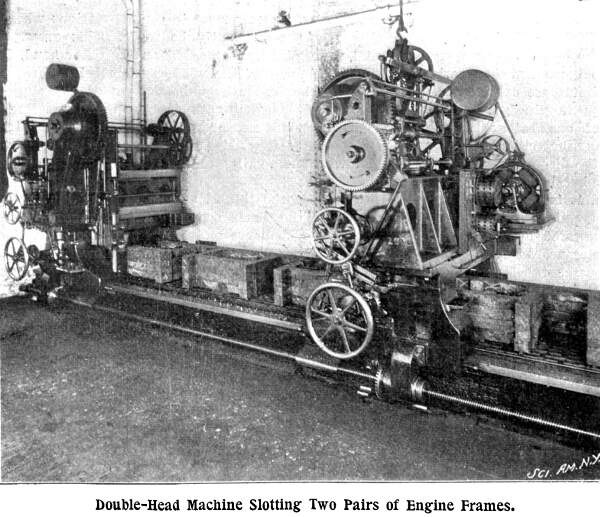 The second engine, built in 1834
for the Charleston & Hamburg Railroad Company, was a six-wheeled
engine with a single pair of drivers, 4½ feet in diameter,
carried behind the firebox, with a half-crank axle of Baldwin's
design. The wood and iron wheels used on the "Ironsides"
having proved faulty, the driving-wheels in this case were cast
in solid bell metal. The "Miller" had cylinders 10 inches
in diameter by 16 inches stroke, and weighed in working order
about 8 tons. The boiler was constructed with a high circular
dome over the firebox, a form of construction which was consistently
followed for many years afterward. The next engine, the "Lancaster,"
built in 1834, weighed about 8½ tons, and in that year
five locomotives were completed. In the following year, the business
having outgrown the works, a location was found on Broad and Hamilton
Streets, the site of the present works, then in the suburbs of
the city. From that time on the growth of the plant was rapid,
fourteen engines being built in 1835 and forty in 1836. Without
attempting to go into the details of the progress of the works,
it is sufficient to state that several standard American types
had their origin in the Baldwin shops, and of these, perhaps the
most notable are the "Consolidation," the "Mogul"
and the "Atlantic" types. The Consolidation," from
which the type of this name was named, was built in July, 1866,
for the Lehigh Valley Railway. She was a remarkably powerful engine
for that day, with cylinders 20 by 24; four pairs of drivers connected,
and a Bissell pony truck equalized with the front drivers. The
engine in working order weighed 90,000 pounds. The "Mogul"
class took its rise from an engine built for the Louisville &
Nashville Railroad in 1861. The "Mogul" had three pairs
of drivers connected, and a swinging pony truck, which was later
equalized with the forward drivers. The first "Atlantic"
type of locomotive was built in 1895 for the Atlantic Coast Line,
which was followed by engines of the same type for the Atlantic
City trains of the Philadelphia & Reading Railroad. The 1,000th
locomotive was built in 1861. The 5,000th locomotive, built in
1880, was designed for fast passenger service between Philadelphia
and New York, and to run with a light train at a speed of 60 miles
per hour; its cylinders were 18 by 24, and it was carried on a
four-wheel truck, one pair of 6½-foot driving wheels, and
a pair of 45-inch trailing wheels equalized with the drivers.
The 10,000th locomotive was completed in 1889; the 15,000th in
1896; and the 20,000th in 1902. The second engine, built in 1834
for the Charleston & Hamburg Railroad Company, was a six-wheeled
engine with a single pair of drivers, 4½ feet in diameter,
carried behind the firebox, with a half-crank axle of Baldwin's
design. The wood and iron wheels used on the "Ironsides"
having proved faulty, the driving-wheels in this case were cast
in solid bell metal. The "Miller" had cylinders 10 inches
in diameter by 16 inches stroke, and weighed in working order
about 8 tons. The boiler was constructed with a high circular
dome over the firebox, a form of construction which was consistently
followed for many years afterward. The next engine, the "Lancaster,"
built in 1834, weighed about 8½ tons, and in that year
five locomotives were completed. In the following year, the business
having outgrown the works, a location was found on Broad and Hamilton
Streets, the site of the present works, then in the suburbs of
the city. From that time on the growth of the plant was rapid,
fourteen engines being built in 1835 and forty in 1836. Without
attempting to go into the details of the progress of the works,
it is sufficient to state that several standard American types
had their origin in the Baldwin shops, and of these, perhaps the
most notable are the "Consolidation," the "Mogul"
and the "Atlantic" types. The Consolidation," from
which the type of this name was named, was built in July, 1866,
for the Lehigh Valley Railway. She was a remarkably powerful engine
for that day, with cylinders 20 by 24; four pairs of drivers connected,
and a Bissell pony truck equalized with the front drivers. The
engine in working order weighed 90,000 pounds. The "Mogul"
class took its rise from an engine built for the Louisville &
Nashville Railroad in 1861. The "Mogul" had three pairs
of drivers connected, and a swinging pony truck, which was later
equalized with the forward drivers. The first "Atlantic"
type of locomotive was built in 1895 for the Atlantic Coast Line,
which was followed by engines of the same type for the Atlantic
City trains of the Philadelphia & Reading Railroad. The 1,000th
locomotive was built in 1861. The 5,000th locomotive, built in
1880, was designed for fast passenger service between Philadelphia
and New York, and to run with a light train at a speed of 60 miles
per hour; its cylinders were 18 by 24, and it was carried on a
four-wheel truck, one pair of 6½-foot driving wheels, and
a pair of 45-inch trailing wheels equalized with the drivers.
The 10,000th locomotive was completed in 1889; the 15,000th in
1896; and the 20,000th in 1902.
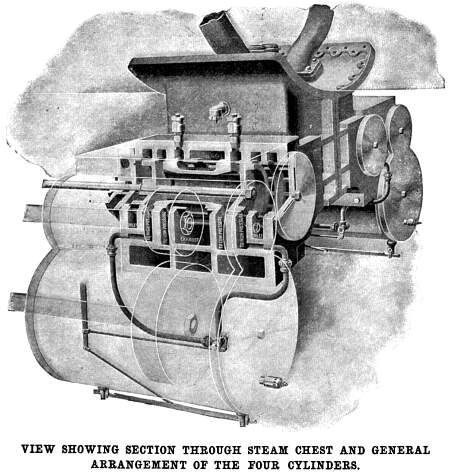 A banner year in the history of
these works was the season of 1889, when the first of the now
celebrated compound locomotives was completed and placed on the
Baltimore & Ohio Railroad. It was of the four-cylinder type
designed by S. M. Vauclain, the general superintendent, a high
and a low-pressure cylinder being carried on either side of the
smokebox, the high-pressure above and the low-pressure below,
although in some later engines the positions are, for convenience,
reversed. The two pistons on either side are connected to a common
crosshead, and each pair of cylinders is cast in one piece with
the piston, steam-chest and one-half of the saddle. The arrangement
is shown very clearly in the accompanying perspective view of
the cylinders. The valve, which is double and hollow, controls
the steam admission and exhaust of both cylinders. The exhaust
steam on the high-pressure cylinder becomes the supply steam for
the low-pressure cylinder; and as the steam for the high-pressure
cylinder enters the steam-chest at both ends the valve is in practically
perfect balance. A by-pass valve is provided to admit live steam
to the low-pressure cylinder in starting. A banner year in the history of
these works was the season of 1889, when the first of the now
celebrated compound locomotives was completed and placed on the
Baltimore & Ohio Railroad. It was of the four-cylinder type
designed by S. M. Vauclain, the general superintendent, a high
and a low-pressure cylinder being carried on either side of the
smokebox, the high-pressure above and the low-pressure below,
although in some later engines the positions are, for convenience,
reversed. The two pistons on either side are connected to a common
crosshead, and each pair of cylinders is cast in one piece with
the piston, steam-chest and one-half of the saddle. The arrangement
is shown very clearly in the accompanying perspective view of
the cylinders. The valve, which is double and hollow, controls
the steam admission and exhaust of both cylinders. The exhaust
steam on the high-pressure cylinder becomes the supply steam for
the low-pressure cylinder; and as the steam for the high-pressure
cylinder enters the steam-chest at both ends the valve is in practically
perfect balance. A by-pass valve is provided to admit live steam
to the low-pressure cylinder in starting.
In view of the fact that there is, even to-day, a rather widespread,
although mistaken, idea among railroad men that the superiority
of the compound to the single-expansion locomotive is doubtful,
it is well to draw attention here to two facts: First, that the
scientific tests which have been made in experimental engineering
laboratories, such as those at Purdue University and Columbia
University, have shown that the compound locomotive is decidedly
more economical than the single-expansion; and, 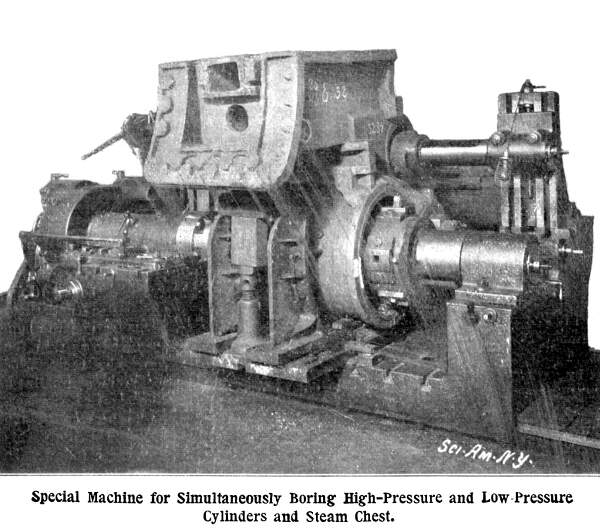 second,
that where the management, engineers and firemen of a railroad
have taken hold of the compound with the determination to give
it a perfectly fair trial, it has not proved more costly in repairs
and has maintained what we might call its laboratorial reputation
for economy. We quote from a paper on the performance of a four-cylinder
Baldwin, compound locomotive, by Richard A. Smart, Assistant Professor
of Experimental Engineering at Purdue University, in which he
draws the following conclusions: First, that there was with an
increase of speed an increase of horse power and economy up to
270 revolutions per minute; second, the indications were that
the power would increase for speeds considerably above 270 revolutions
per minute; third, the increase in economy with increase of speed
was chiefly due to a decrease of cylinder condensation; fourth,
the average steam consumption of the compound was much lower than
the lowest consumption shown by the single-expansion engine; fifth,
the saving in steam shown by the compound locomotive would result
in a saving in coal of from 18 per cent to 33 per cent. second,
that where the management, engineers and firemen of a railroad
have taken hold of the compound with the determination to give
it a perfectly fair trial, it has not proved more costly in repairs
and has maintained what we might call its laboratorial reputation
for economy. We quote from a paper on the performance of a four-cylinder
Baldwin, compound locomotive, by Richard A. Smart, Assistant Professor
of Experimental Engineering at Purdue University, in which he
draws the following conclusions: First, that there was with an
increase of speed an increase of horse power and economy up to
270 revolutions per minute; second, the indications were that
the power would increase for speeds considerably above 270 revolutions
per minute; third, the increase in economy with increase of speed
was chiefly due to a decrease of cylinder condensation; fourth,
the average steam consumption of the compound was much lower than
the lowest consumption shown by the single-expansion engine; fifth,
the saving in steam shown by the compound locomotive would result
in a saving in coal of from 18 per cent to 33 per cent.
 Perhaps the most celebrated locomotives
turned out by these works are those which have been built to haul
the extremely fast trains which are running between Camden, across
the Delaware River from Philadelphia, and Atlantic City. These
are of the celebrated "Atlantic" type in which the cylinders
drive the rear pair of four-coupled drivers and the weight of
the firebox is carried by a pair of trailers. Engine 1027 was
built under guarantee to haul a train of eight cars (four coaches
and four Pullmans) to Atlantic City, a distance of 55.5 miles,
in sixty minutes; or to haul six cars over the same distance in
fifty minutes, with a development of an estimated horse power
of 1,400. In practice, however, this locomotive exceeded the guarantee
by about 10 per cent. Another of the "Atlantic" type
was built for the Chicago, Milwaukee & St. Paul Railroad,
under contract to haul nine cars between Milwaukee and Chicago
in one hour and forty-five minutes, with an estimated development
of maximum horse power of 1,600. One of the latter engines exceeded
the guarantee by four cars, hauling thirteen cars, in the specified
time, the train and locomotive together weighing 600 tons. Following
on these excellent results the company proceeded to make accurate
tests of 1027 to determine just what the locomotive was capable
of. It was found that with an experimental train of twelve coaches
the horse power increased directly with the speed until it reached
1,450 horse power at 70 miles an hour, and even at this speed
the locomotive had a reserve of power to overcome grade resistance
or to enable it to accelerate the train to a higher speed. Perhaps the most celebrated locomotives
turned out by these works are those which have been built to haul
the extremely fast trains which are running between Camden, across
the Delaware River from Philadelphia, and Atlantic City. These
are of the celebrated "Atlantic" type in which the cylinders
drive the rear pair of four-coupled drivers and the weight of
the firebox is carried by a pair of trailers. Engine 1027 was
built under guarantee to haul a train of eight cars (four coaches
and four Pullmans) to Atlantic City, a distance of 55.5 miles,
in sixty minutes; or to haul six cars over the same distance in
fifty minutes, with a development of an estimated horse power
of 1,400. In practice, however, this locomotive exceeded the guarantee
by about 10 per cent. Another of the "Atlantic" type
was built for the Chicago, Milwaukee & St. Paul Railroad,
under contract to haul nine cars between Milwaukee and Chicago
in one hour and forty-five minutes, with an estimated development
of maximum horse power of 1,600. One of the latter engines exceeded
the guarantee by four cars, hauling thirteen cars, in the specified
time, the train and locomotive together weighing 600 tons. Following
on these excellent results the company proceeded to make accurate
tests of 1027 to determine just what the locomotive was capable
of. It was found that with an experimental train of twelve coaches
the horse power increased directly with the speed until it reached
1,450 horse power at 70 miles an hour, and even at this speed
the locomotive had a reserve of power to overcome grade resistance
or to enable it to accelerate the train to a higher speed.
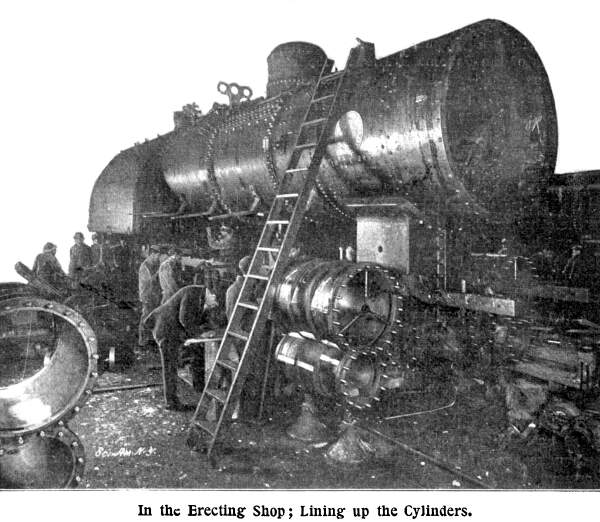
It is a well-known fact that at the higher speeds the single-expansion
locomotive is subject to drawbacks in the shape of wire drawing
of the steam, back pressure in the cylinders and overforcing of
the fire, which are absent in the compound with its wider range
of expansion and its milder exhaust. Careful tests have shown
over and over again that there is about 25 per cent economy in
a compound as compared with a single-expansion locomotive doing
the same work. This is due to the less evaporation required to
develop the necessary energy, together with the slower rate of
combustion of fuel resulting from exhausting the steam at lower
tension. Of course, it is understood that these results are only
obtained, as we have before remarked, where the management and
operatives of the road are in thorough sympathy with the compound,
and are desirous of giving it every facility to show its best
results.
 The 20,000th locomotive, of which
we present an illustration, is a further improvement in which
it is sought to secure a more perfect balance of the reciprocating
parts than is possible on the ordinary type. The high and low-pressure
cylinders, instead of being arranged above one another in a vertical
plane, are all carried in one horizontal plane, the high-pressure
cylinders within the frames beneath the smokebox and the low-pressure
cylinders on the outside of the frames. The low-pressure crossheads
are connected with the main driving wheels by outside connecting
rods as in ordinary practice. The main driving axle has two cranks,
which are set at right angles to each other on each side of the
center of the locomotive, and each crank is coupled to the crosshead
of one of the high-pressure pistons. The crank on the axle and
the crank-pin in the wheel for the corresponding high and low-pressure
cylinders are set at an angle of 180 degrees, and the two axle
cranks being set at 90 degrees results in the action of each high
and low-pressure cylinder, on one side of the locomotive quartering
with the equivalent cylinders on the opposite side. As a consequence,
an almost perfectly balanced engine is secured, and the amount
of counter-balance required is reduced to a very low limit. The
arrangement is the same as was used by Strong in his locomotive
that attracted so much attention a dozen or more years ago, and
it has lately been adopted with very good results on two or three
of the English roads. Other special features of No. 20,000 are
that it carries the Vanderbilt boiler and tender. In the former
the firebox is cylindrical and corrugated, and in the tender the
water tank is cylindrical, and the coal box is built at the front
end of the tender and is, therefore, very conveniently placed
for the fireman. The locomotive weighs in working order 176,510
pounds, of which 127,010 pounds are on the driving wheels. The
weight of the tender loaded is 99,000 pounds. The driving wheels
are 73 inches in diameter and the cylinders are 15 and 25 in diameter
by 26 inches stroke. The boiler has a total heating surface of
2,793 square feet, of which 128 square feet are in the firebox. The 20,000th locomotive, of which
we present an illustration, is a further improvement in which
it is sought to secure a more perfect balance of the reciprocating
parts than is possible on the ordinary type. The high and low-pressure
cylinders, instead of being arranged above one another in a vertical
plane, are all carried in one horizontal plane, the high-pressure
cylinders within the frames beneath the smokebox and the low-pressure
cylinders on the outside of the frames. The low-pressure crossheads
are connected with the main driving wheels by outside connecting
rods as in ordinary practice. The main driving axle has two cranks,
which are set at right angles to each other on each side of the
center of the locomotive, and each crank is coupled to the crosshead
of one of the high-pressure pistons. The crank on the axle and
the crank-pin in the wheel for the corresponding high and low-pressure
cylinders are set at an angle of 180 degrees, and the two axle
cranks being set at 90 degrees results in the action of each high
and low-pressure cylinder, on one side of the locomotive quartering
with the equivalent cylinders on the opposite side. As a consequence,
an almost perfectly balanced engine is secured, and the amount
of counter-balance required is reduced to a very low limit. The
arrangement is the same as was used by Strong in his locomotive
that attracted so much attention a dozen or more years ago, and
it has lately been adopted with very good results on two or three
of the English roads. Other special features of No. 20,000 are
that it carries the Vanderbilt boiler and tender. In the former
the firebox is cylindrical and corrugated, and in the tender the
water tank is cylindrical, and the coal box is built at the front
end of the tender and is, therefore, very conveniently placed
for the fireman. The locomotive weighs in working order 176,510
pounds, of which 127,010 pounds are on the driving wheels. The
weight of the tender loaded is 99,000 pounds. The driving wheels
are 73 inches in diameter and the cylinders are 15 and 25 in diameter
by 26 inches stroke. The boiler has a total heating surface of
2,793 square feet, of which 128 square feet are in the firebox.
Build a Locomotive
| Contents Page
|







